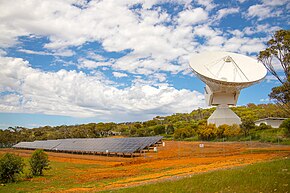New Norcia Station
 New Norcia Station antenna and solar power plant | |
| Alternative names | DSA 1 |
|---|---|
| Named after | New Norcia |
| Part of | ESTRACK |
| Location(s) | Western Australia, AUS |
| Coordinates | 31°02′54″S 116°11′28″E / 31.0482°S 116.191°E |
| Organization | European Space Operations Centre |
| Altitude | 252 m (827 ft) |
| Telescope style | ground station |
| Diameter | 35 m (114 ft 10 in) |
| Replaced | Perth Station |
| Website | www |
| | |

New Norcia Station (also known as NNO) is an
.The station operates a 35-metre dish designated NNO-1
New Norcia Station was one of the stations providing communications, tracking and data download from the Rosetta spacecraft.[4] It supports the BepiColombo mission.[1]
History
Construction began in April 2000 and lasted until the end of the first half of 2002. Installation of electronics and communication equipment followed. The station was officially opened on 5 March 2003 by the Premier of Western Australia at the time, Dr Geoff Gallop. Total construction cost was €28 million.[2]
In December 2019, ESA announced plans to build a second 35 metre deep space antenna at New Norcia[5] to provide coverage for upcoming ESA missions, including Solar Orbiter, Hera, and Jupiter Icy Moons Explorer. This is due for completion in late-2024. The antenna is due to enter operation in early-2025.
Since June 2019, operational support and maintenance of the station has been the responsibility of CSIRO.
NNO-2

A new 4.5-metre dish designated NNO-2 was inaugurated on 11 February 2016.[6] NNO-2 acts as an acquisition aid for the 35-metre dish for fast-moving satellites and launch vehicles during their launch and early orbit stage.
The NNO-2 mount is capable of tracking at 20 degrees per second in azimuth and 10 degrees per second in elevation.
The 4.5-metre dish has a half-power beam width of 1.9 degrees at S-band and 0.5 degrees at X-band and can be used to communicate with spacecraft up to 100,000 kilometres in altitude. To help in signal acquisition when the spacecraft position is too uncertain, the 4.5-metre dish has a 0.75-metre dish piggy-backed onto it, with a half-power beam width of 3.5 degrees at X-band. There is no S-band capability on the 0.75m dish.
NNO-2 may also be operated independently of NNO-1, as it commonly does during support activities for launches of Ariane 5, Vega, and Soyuz rockets from the Guiana Space Centre.
References
- ^ ESA. Retrieved 18 August 2014.
- ^ ESA. 3 March 2003. Retrieved 18 August 2014.
- ESA. Archived from the originalon 12 August 2014. Retrieved 18 August 2014.
- ESA. 18 August 2014. Retrieved 18 August 2014.
- ^ "ESA to Peer into Deep Space with New Antenna". Asgardia Space. 13 December 2019. Retrieved 2 January 2020.
- ESA. Retrieved 20 February 2014.
External links
- Talking to Satellites in Deep Space from New Norcia, chapter from ESA Bulletin, May 2003.
- Europe’s Access to Deep Space: The Deep Space Ground Station in Australia


